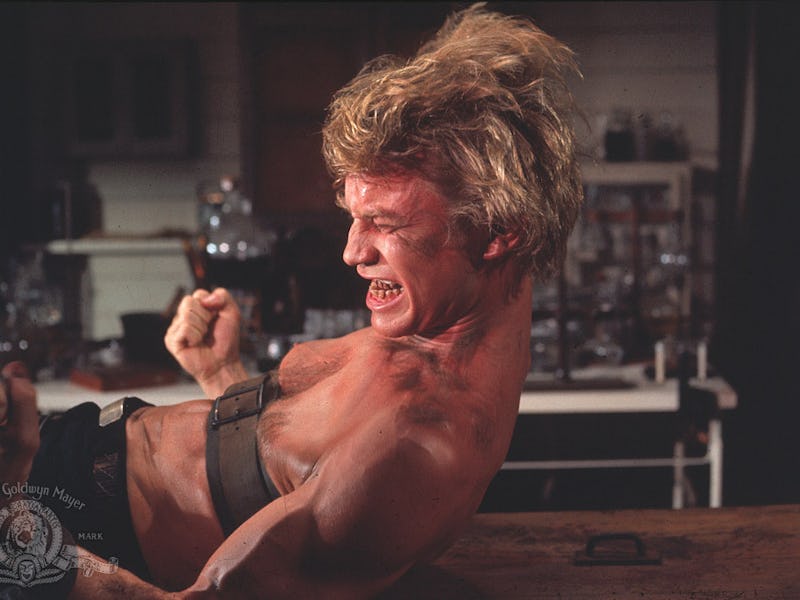45 years ago, the best H.G. Wells movie changed sci-fi horror forever
Most H.G. Wells adaptations get this wrong. But in 1977, one movie finally nailed it.

There’s a lesson Hollywood fails to learn time and again when it comes to adapting the work of H.G. Wells: it’s all about the creatures. Even high-quality attempts like Steve Spielberg's War of the Worlds miss the mark in this crucial category, but one movie totally nails its Wellsian source material — even if it racks up some other issues along the way.
Loosely adapted from one of H.G. Wells' most enduring novels, The Island of Dr. Moreau (1977) was only the source material’s second shot at the big screen. Unlike the eponymous 1996 remake to come decades later with Marlon Brando in the titular role, along with an equally confused-to-be-here Val Kilmer, Don Taylor's follow-up to 1932's The Island of Lost Souls leaned into what's most satisfying about Wells' original material. The creatures themselves.
In Dr. Moreau the hybrid "humanimals” tend to be the most human and dimensional characters onscreen, making the film's elaborate setup all the more compelling, yet unsettling. That's sort of what Wells was going for, after all.
The plot is one you've seen adapted and referenced time and again, from Sherlock Holmes to Johnny Bravo — even the 1997 video game Fallout took a shot at the classic story. A shipwrecked man named Andrew Braddock (Michael York) wakes up on an island inhabited by a mysterious scientist named Dr. Paul Moreau (Burt Lancaster). Welcomed initially as a guest, Braddock quickly takes kindly to the island's other residents, though Moreau warns him fiercely not to leave the compound at night.
You can probably predict what happens next.
Practical prosthetics and makeup work deliver just the right balance of campy and ghastly.
It's not long before Braddock discovers the haunting truth about this island and its eccentric ruler. He's been experimenting on animals by injecting them with a serum that erases “the natural instincts of the animal,” allowing him to perform surgeries that mold the creatures into human beings. The hybrids still act like beasts for the most part, but the film goes on to show that they evolve quickly. One of them can even speak.
One of the most chilling aspects of this development is how normal this becomes for everyone else on the island. It's one thing to have an audience surrogate horrified at the sight of a beast with the face of a man staring him down. It's even scarier to see him surrounded by people who barely care.
It also helps that the humanimals themselves are terrifying to look at. Practical prosthetics and makeup work deliver just the right balance of campy and ghastly.
It's easy to see why The Island of Dr. Moreau failed to wow audiences and critics with its hybrid creatures. It wasn't exactly breaking new ground, despite having a reported budget of around $6 million (by contrast, Jaws cost about $9 million just a couple of years earlier).
But the creatures looking eerily familiar is sort of the point, isn't it? Wells constantly prodded his readers to examine their own perception of reality. Be it an alien invasion or mankind unlocking the true power of DNA, both premises can lead to horrifying consequences. But in the end, science tends to be a little misshapen, imperfect in all the perfect ways. The anxiety in your gut has less to do with sheer terror at the sight of a human losing themselves to a beast transformation and more to do with the implications of what that would mean if this same body horror was inflicted upon you.
Though The Island of Dr. Moreau crawls a bit in its first two acts — complete with a hopelessly redundant and obligatory love scene — the third is unrelenting chaos. (You may also feel uncomfortable in the knowledge that the real-life animals used in the film were almost certainly mistreated in many ways. This was the ‘70s, after all, long before regulations caught up to the studio system.)
Burt Lancaster on the set of The Island of Dr. Moreau.
Hollywood may have changed its ways for the better, but modern cinema still owes a debt of gratitude to The Island of Dr. Moreau. Even S. S. Rajamouli's breakout action-epic RRR borrows liberally here when it comes to animal vs. human mayhem, albeit with CGI animals to keep things above board.
But where that film relishes in the technologically absurd, The Island of Dr. Moreau uses absurdity as a sermon. Its preacher is Moreau himself, more a religious man (or cult leader, really) than scientist. And this disaffected persona is played off brilliantly by Lancaster, the best actor to ever inhabit the role. He's charming, yet irreverent. Horrific, yet mild-mannered. It’s as if Mr. Hyde's other persona were Dr. Frankenstein instead of Jekyll, with a little Dracula thrown in.
When it comes to the ‘70s, you can find plenty of cutting-edge films to devour. As a result, some of the moodier popcorn horror/sci-fi of the era tends to get overlooked, and perhaps unfairly so. If you're brave enough, it might be time to visit (or revisit) Dr. Moreau's island. You might not come back from it the same.